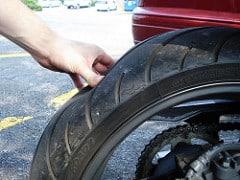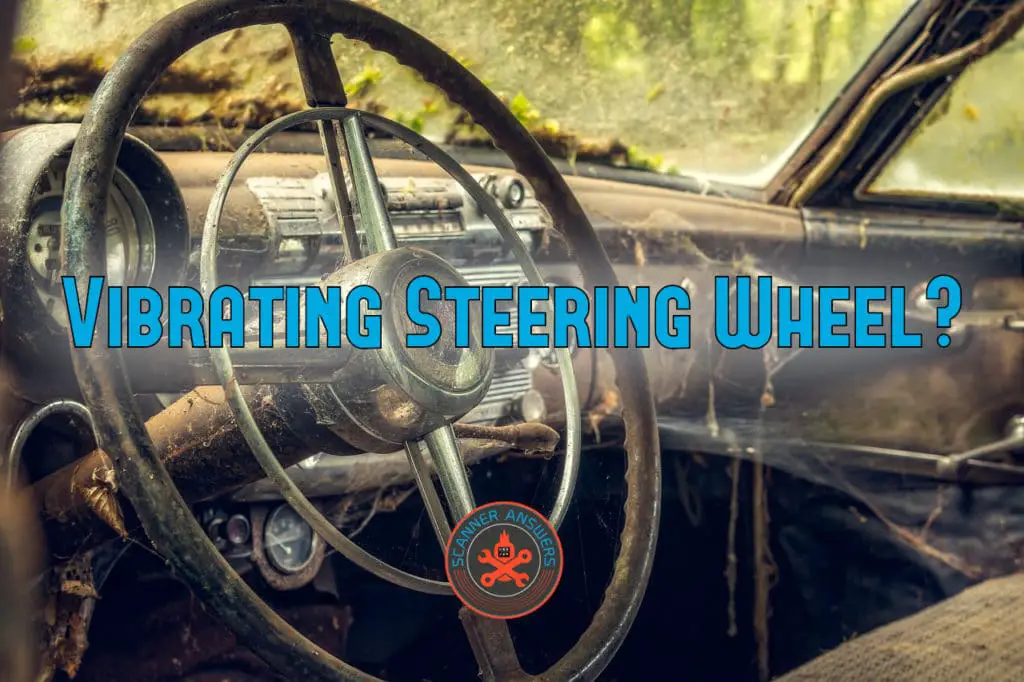The List of Possible Causes of Vibrating or Shaking Steering Wheel when Driving
It can happen at any time without warning. Sometimes, it happens intermittently and will disappear altogether.
Hey I’m Vince –
Have you ever wondered why your steering wheel shakes at high speeds? I’m talking about a wobbly, shaking, or vibrating steering wheel when driving your car. Have you ever felt this before? If not, you’re in luck. But if you’re reading this, I assume you’re searching for the cause of that irritating wobble or shaking of the steering wheel.
Read more about steering wheel noises: Clunking Noises When Turning the Steering Wheel
Don’t worry too much. If the car is still good enough to drive despite the problem, you might be dealing with an issue on the tires, suspension, brakes, or wheels. Those are the first things that need to be checked at the first sign of a vibrating steering wheel.
First things first
if your car is relatively new and still covered by the warranty, take it back to the dealership. Let them handle the repairs. With their plethora of sophisticated diagnostic machines, an expert technician can easily determine the cause of a shaky or wobbly steering wheel.
However, if you have an older car, keep reading because you may be able to fix it yourself. There are many possible causes of a vibrating steering wheel while driving. If you notice this symptom the next time you go for a drive, stop the car in a safe place, activate the hazard lights, and check the front tires for damage or cupping. We’ll discuss more on this later.
But if the steering wheel vibrates when you step on the brake pedal, you might be dealing with warped brake rotors or faulty calipers. Do you feel the steering wheel vibrating or shaking only at low speeds? You might need to purchase new tires.
You see, the list of possible causes will vary. So let’s get down to business.
3 Reasons for steering wheel shakes at high speeds
Remember that tire wobble is consistent at a specific vehicle speed. You might feel the steering wheel vibrate at low speeds and it may disappear as you speed up. Pay attention. I used to have this same problem in my wife’s Mitsubishi Mirage. There is no steering wobble at 15 to 20 mph, but I can feel the severe vibration at speeds of 30 to 50 mph!
Granted the car was still new, I immediately found out the culprit of a vibrating steering wheel at low to medium speeds: inadequate or faulty tire balancing.
That’s right. Something so small and trivial can cause such a worrying problem. Let’s examine the causes of a vibrating steering wheel that only occurs at certain speeds.

1. Steering wheel wobble at low speed (less than 20mph)
If you feel the steering wheel shaking at low speeds or your car is shuddering when accelerating, this is the first sign of tire failure. This sort of problem can also be caused by a badly damaged or bent wheel and cupping tires. But most of the time (and especially at low speeds), you might be dealing with tire separation.
Dont cheap out on your mud tires!
That sounds bad, right? Yup.
Tire separation means the treads are falling apart. This is a serious safety issue, especially if the tires in your vehicle are worn, bald, or if the front tires are more than five years old. Here’s how you should inspect your tires:
- Park the car in a safe place so you can inspect the front tires. Look for visible bumps on the surface of the tread. Most of the time, the tread separation happens near the center rib of the tire. It’s like the tire is broken in half from the inside, and you will feel this as you run your hand over the face of the treads! If this is the problem, take the car to a tire shop immediately and get yourself a new set of tires.
- If you didn’t see any signs of tire separation (especially if the tires are relatively new), check for signs of cupping. Run your hand over the tire and see if you can feel wavy sections in the tread. The surface should be flat in the first place! If this is the case, you will need to buy new tires.
- If there are no signs of tire separation or cupping, check the tire for flat spots. Run your hand on the face of the tire and check for certain sections that are flat or shaved off. This is the result of locking up the brakes and hearing the tires screeching on the road. Checking for flat spots is easier if you remove the wheels from the hub. If you don’t, the flat spot might be near the patch of the tire that is touching the ground, hence making it tricky to diagnose.
- Checking for a bent, cracked, or damaged wheel can be difficult unless you remove the wheel from the hub. But in some cases, you can easily see bent portion of the wheel. It can either be on the outside or inside of the wheel. In severe cases, the wheel can be cracked or split in half. It just so happens the tire and the tire pressure are the only things keeping the wheel from falling apart. Take your vehicle to the nearest tire dealer for a thorough inspection.
Again, if you feel consistent shaking at low speeds, check the condition of the front tires. If you feel the rear of the car shaking or wobbling at low speeds, check the rear tires.
More often than not, premature tire wear or damage is inherent on those cheaper tire brands. I’m not saying cheap tires are inferior (because certain cheap tires are actually good value for money), but if you’re paying way less money on a new set of tires, you better be wary. Inferior quality tires are often constructed using weaker belt seating and tread layers, which will result in ‘oblong’ tires.

In some cases, premature tire damage or wear can also be caused by suspension or alignment issues. Worn out suspension components will severely affect how the tires are making contact with the road surface. If there is excessive play in the suspension, maintaining the proper wheel alignment will be next to impossible. This problem can cause severe tire wear or uneven tread wear.
If you previously felt the vehicle pulling to one side in straight-line driving, and there are now vibrations in the steering wheel, this means one or both tires are wearing unevenly. Pulling can be caused by improper wheel alignment caused by worn out suspension or steering components, bad camber or toe adjustment on the front wheels, or using incorrect tires.
Yes, using a different or wider tire size may cause problems with steering and handling, which in turn will lead to accelerated tire wear. I had a sports coupe equipped with 17-inch wheels. I purchased a new set of wider tires (235/40/R17) to improve the stance of my ride. To my horror, my car immediately had a pulling sensation at the wheel after installing the front tires. After 2-3 days of driving, the tires had signs of uneven wear. I had no choice but to purchase a new set of tires.
To avoid lots of these tire issues, make sure to keep an eye on the Low Tire Pressure light and inflate your tire pressure to their correct levels!

2. Vibrating steering wheel (30 – 50 mph)
You need to consider two things if you feel the steering wheel vibrating at speeds of 30 to 50 mph. It can be caused by improper tire/wheel balancing, or probably a moderately bent wheel. If you’re not sure, it is best to take your vehicle to the nearest tire shop. The technician will remove the wheel from the hub and run it on a balancing machine. All the existing weights attached to the wheel will also be removed to determine the proper balance.
What does tire balancing do?
Simply put, tire balancing is designed to reduce vibrations in the steering, suspension, and chassis as you drive the vehicle. After fitting new tires to the wheels, the front wheels should be rebalanced with the new tire using a balancing machine. If the machine detects imbalance, the technician will stick or apply corrective weights to the inside of the wheel. This will serve to counteract the unbalanced nature of the wheels and tires.
3. Wobbly or vibrating steering wheel at higher speeds (50 mph upwards)
Most of the time, a vibrating steering wheel at higher speeds can be caused by improper tire balancing or engine and drivetrain issues. There are times when a misfiring engine will transmit the vibrations to the steering wheel, which will cause the tiller to shake or wobble. In some cases, broken or faulty engine mounts or transmission mounts may also cause the steering to wobble.
We recommend grabbing an Android or iPhone OBD2 scan tool and doing a full diagnostics scan.

Other common causes of steering wheel vibration or wobble
If all the tires and wheels are fine and you still feel the steering wheel shaking or vibrating as you drive, it is time to consult a professional mechanic. There could be problems with the suspension, brakes, wheel bearings, or the chassis.
- The wheel bearings will also cause mild vibrations, but they are easy to diagnose before they go from bad to worst. Broken or faulty wheel bearings will emit an annoying high-pitched squeaking noise when turning. The noise will get louder and will eventually turn into a disconcerting grinding squeal as the wheel bearings get damaged. At first, the noise will be absent at low speeds. As the wheel bearings reach the end of their useful life, the grinding noise will be present even at low speed.
- Check the condition of the shock absorbers. Broken front shocks or bad struts may cause the steering to wobble or vibrate on a variety of speeds and road surfaces. Then again, it is easy to diagnose broken or worn out shock absorbers. If your car is fitted with hydraulic shocks from the factory, check for signs of fluid or oil leaks on the wheels, axle, or hubs. If your vehicle is fitted with gas-type shocks, you will need to press down on the shocks and check to see for excessive bounce. The theory is the shocks will need to bounce only once after pressing hard on one side of the vehicle. This means the shocks are okay. But if the shocks feel overly stiff or if the vehicle bounces, it is time to replace the shocks.
- Have a mechanic check the condition of the ball joints and tie rods for wobble. If you feel the vibration when turning the wheel or while cornering, there is a problem with the tie rod ends. But if the steering wheel shakes in straight-line driving, the ball joints might need to be replaced. Tie Rods can also cause a clunk when turning.
- Check for bent or broken axles. If the steering wheel vibration began after the car was involved in an accident, you might be dealing with damaged axles. Axle damage can also be felt at both low and high speeds, with the vibration getting stronger at higher speeds.
- Violent shaking of the steering wheel while applying the brakes is a sure sign of warped rotor discs. The remedy is to remove the wheels and check surface of the rotor using a digital caliper or similar measuring tool. The surface of the disc should have a consistent thickness. If there are certain parts of the disc that are warped, you will need to replace the discs or have them skimmed at a machine shop.
- Violent tremors or shaking while braking can also be caused by faulty, rusted, or sticky calipers. If this is the case, look for signs of thick brake dust on the front wheels, or check the temperature of the wheels after a short drive. The side which is too hot to the touch will have a sticking brake caliper. This condition can also damage the brake discs in the long run.
Conclusion
As you have learned, there are many possible causes of a vibrating sensation in the steering wheel. This problem is mostly caused by tire issues, so it’s a good idea to check the front tires first before moving on to other possible faults. Early diagnosis is the secret in preventing accidents or damage. If you feel the steering wheel vibrating, have the tires or the alignment checked and corrected. Again, if you feel the steering wheel vibrating at lower speeds, take the car to the nearest tire center immediately.
